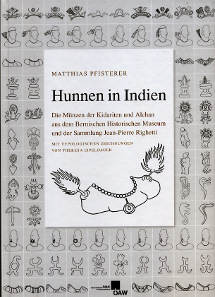by Ursula Kampmann
translated by Teresa Teklic
October 9, 2014 – On hearing the word “Huns”, even historians won’t be able to come up with much more than the name “Attila”. Only very few people are aware of the fact that further Hunnish kingdoms existed in the border area between Iran, Central Asia and India. The knowledge that coin collectors and numismatists have of the Kidarite kingdom or that of the Alchan is equally limited. This is evident when looking at the fact that similar coins which originated in these kingdoms are often described in auction and collection catalogues very differently, depending on the state of research reflected in the reference work that was available to the catalogues’ editors at the time of publication.
Matthias Pfisterer, Hunnen in Indien. Die Münzen der Kidariten und Alchan aus dem Bernischen Historischen Museum und der Sammlung Jean-Pierrre Righetti. Mit typologischen Zeichnungen von Theresa Eipeldauer. Verlag der Österreichischen Akademie der Wissenschaften, Vienna, 2013. 30.2 x 22.2cm, 335 pp. images in b/w. Hardcover. ISBN: 978-3-7001-7372-4. Price: 89 euros.
So you keep hoping for a new work of reference that will once and for all end this catalogue madness. Now Matthias Pfisterer has paved the way. In revising the catalogues of the collection at the Historical Museum in Bern (Switzerland) and that of private collector Jean-Pierre Righetti, Pfisterer not only consulted these two collections, but many others: in Islamabad, New York, Toyko and many more places, as the book’s acknowledgment indicate.
The greatly widened scope of available material provides a real treasure and enables new insights in this field of numismatic research, which currently enjoys great popularity. In 2010 for instance, Joe Cribb published his seminal paper on the Kidarites (Joe Cribb, The Kidarites, the Numismatic Evidence. With an Analytical Appendix by A. Oddy, in: Coins, Art and Chronology II – The first millennium C.E. in the Indo-Iranian borderlands. Wien 2010), so that the author of “Hunnen in Indien” (“Huns in India”) could afford to limit the respective chapter to a five-page summary.
His study on Alchan coinage, on the other hand, comprises some 170 pages and, due to the much increased quantity of material today, far exceeds the scientific scope of Robert Göbl’s four-volume publication “Dokumente zur Geschichte der iranischen Hunnen in Baktrien und Indien” from 1967.
Mind you, Matthias Pfisterer lays no claims to rewriting the history of the forgotten Alchan people. He successfully limits himself to describing the Alchan coin history, including a reconstruction of the structure and system of Alchan coinage, in as much detail as possible. The publication, written according to the Viennese system (“Wiener Aufbau”), is difficult to read but provides a valuable starting point for further research. For that reason, the text addresses only an extremely limited audience. Almost everyone consulting it prior to the publication of a catalogue will immediately jump to page 207, where the collection catalogue Bern/ Righetti begins.
What you’ll find is a catalogue categorised into Göbl’s types. However, those who believe that they can finally go without Göbl’s difficult to obtain publication from 1967 and expect to find a comprehensive compendium of all types of Kidarite and Alchan coins in the new book, will be disappointed. The catalogue includes only those types that are kept in Bern or the Righetti collection. The other types are missing. Again and again, there are major gaps, between 19A and 24, between 24 and 28, between 28 and 33 and many more instances. That’s really unfortunate. Especially because Cribb’s typology of the Kidarite coins isn’t user-friendly at all either. It would have been incredibly convenient if the resources assembled from the collections in Islamabad, New York and Kyoto hadn’t been made available exclusively for researchers, but also in a comprehensive, complementary catalogue in order to facilitate the often complicated, often time-pressured work of catalogue publishers in the future.
At least the photos’ quality is good so that types can be identified and retrieved pretty easily. The pictures are complemented by a detailed description as well as an occasional commentary, plus quotations referring to the Göbl and Cribb publications. All objects of the Bern and Righetti collection are depicted and the index helps to quickly locate the chapter – yes, the chapter and not the page, which addresses the relevant type.
On the whole, an excellent scientific publication with important new insights for numismatic research. The anonymous and international peer-review that the manuscript was subjected to prior to its publication presumably came to the same conclusion. However, as a common user you sometimes wish there would be an “impeer-review” and let’s pretend for a moment that this is an actual word in the English language. I am sure that many scholars would be surprised to find out that their publications are not only consulted by their own kind, but also by normal people, who have different needs and expectations when it comes to books.




